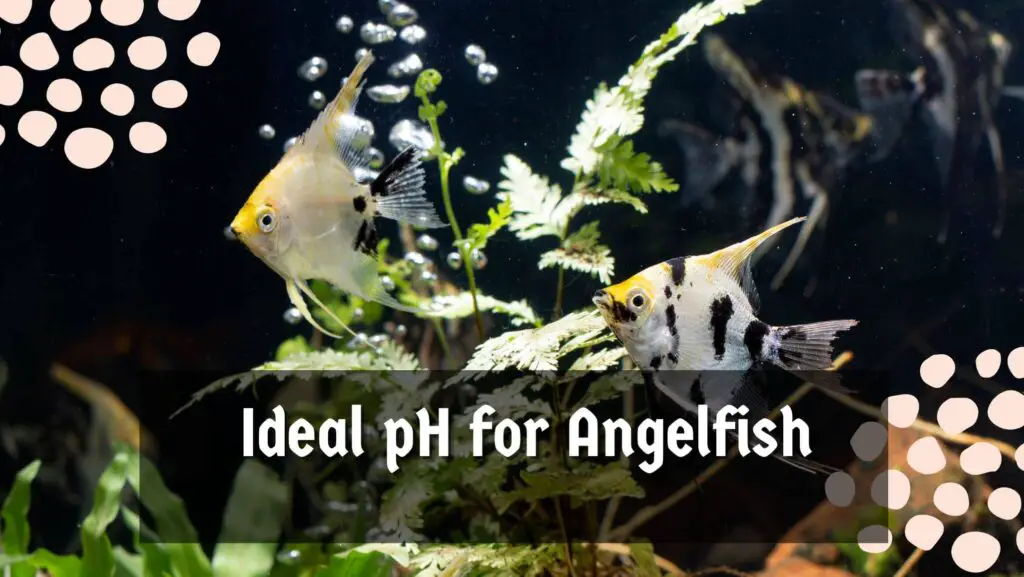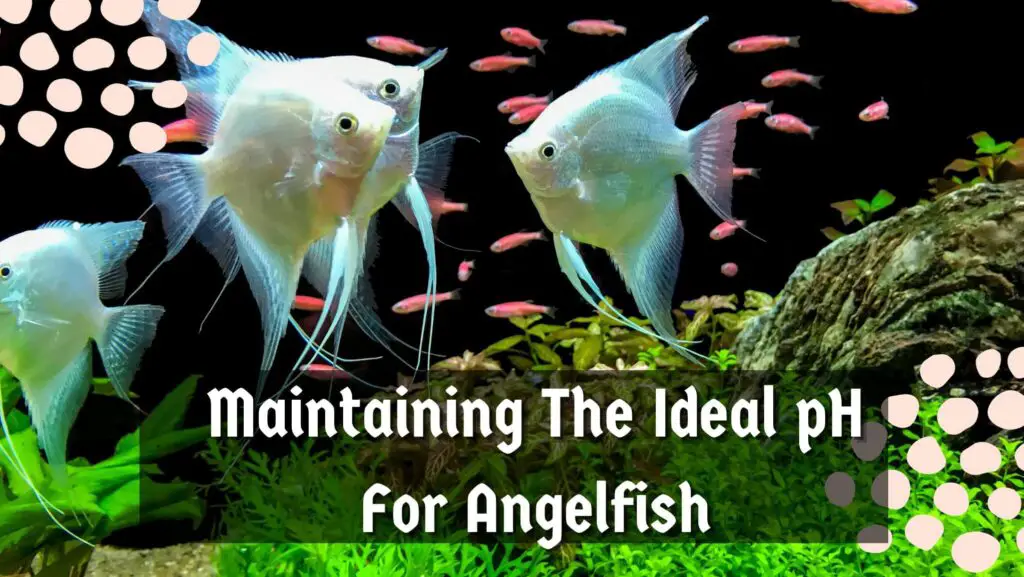
If you are recently adopting Angelfish and looking to know their ideal pH, this is the article for you. In this article, I will discuss the ideal pH level for Angelfish or the best pH for Angelfish and the factors that may influence the pH level.
We will also discuss the practical tips for maintaining the ideal PH range for Angelfish and the effects of improper pH on these elegant fish. But before I tell you all of this, let’s begin with knowing the ideal pH for Angelfish & the factors influencing it.
Ideal pH for Angelfish

Different species of Angelfish can have slight variations in their preferred pH range. However, the popular freshwater angelfish species typically prefer a pH range of 6.5 to 7.5.
You need to maintain the ideal pH range in the tank by adjusting it from time to time using both chemical & natural methods to achieve desired levels. However, before I tell you how you can manage the pH level of an Angel fish tank, let’s discuss the factors affecting the pH in aquariums as well.
3 Factors Affecting pH in Aquariums
Three major factors may influence the pH level within an angelfish aquarium. Therefore I am listing those factors below to help you understand this consideration as well as help you create & maintain a stable, suitable environment for your fish.
Biological Factors
The nitrogen cycle plays a significant role in maintaining the pH balance in almost all aquariums. You should note beneficial bacteria usually convert the toxic ammonia produced by angelfish waste into less harmful nitrate through nitrification.
Therefore this process can result in a slide fluctuation in the pH level inside the tank, particularly during the initial stages of establishing a new aquarium. Conversely, the accumulation of angelfish waste or uneaten food can also increase acidity within the aquarium.
Also, decaying plant matter can increase the acidity inside the aquarium. These organic materials release compounds that alter the pH levels, resulting in fluctuations that may stress the Angelfish.
Therefore I recommend you understand the nitrogen cycle properly and implement proper waste management practices like regular water changes. You must maintain a clean aquarium responsible for pH level and a healthy environment for your Angelfish.
Chemical Factors
There are many kinds of substances, like limestone, crushed coral, or specific rocks, that are known to have natural buffering properties. You can use these substances to stabilize pH levels by preventing drastic changes.
When you add this kind of substance inside an aquarium, it acts as a reservoir of minerals, releasing them slowly into the water and counteracting shifts in pH caused by organic processes or chemical imbalances.
Therefore I recommend you introduce these kinds of PH buffering substances inside your angelfish aquarium as it is beneficial. Also, if you are using tap water with low buffering capacity or unstable pH levels, buffering substances can help you a lot.
However, ensure you are doing your proper ResearchResearch and choosing the one that is safe for Angelfish and compatible with your specific setup. Commercially you can find many PH pers and conditioners available to adjust and maintain the desired pH level inside your angelfish aquarium.
However, choose these products carefully as they may contain chemicals that can raise or lower the pH level allowing you to fine-tune the water parameters according to your fish needs.
If you are using pH-altering products, I will highly advise you to stick with the instructions provided by the manufacturer and make gradual adjustments to avoid setting pH changes that may result in unwanted stress and anxiety for your angel fishes. To know more about their ability to adapt, consider checking my indepth article on: Are Angelfish Hardy?
Environmental Factors
Another crucial fracture that may influence the pH level is the light intensity. You should know that light plays a huge role in the photosynthesis process of aquatic plants. Therefore, if you have any aquatic plants in your aquarium, like algae, intense lighting will promote their growth, producing more carbon dioxide.
According To Atlas Scientific, increased CO2 levels will further decrease the Ph level by forming carbonic acid within the aquarium. As a result, your PH level will significantly drop, potentially affecting your angelfish longevity and well l-being.
Therefore, you must manage the pH level affected by light intensity by striking a balance between adequate light for plant growth and preventing excessive algae growth.
I recommend you choose the right type of lighting setup where you can control its period & intensity. Also, employ regular maintenance practices like algae removal, further maintaining a stable pH level.
Maintaining The Ideal pH For Angelfish

If you want to maintain the ideal pH level within the tank for your fish, make sure you’re paying attention to regular testing and monitoring as a necessary part of their care. Regularly testing the pH levels in your aquarium is crucial for maintaining a healthy environment for your Angelfish.
You can easily find pH testing kits in local pet stores or online. Don’t worry about using this, Kate, because they are great at providing quick & accurate assessment of the water’s pH. However, I recommend you choose the one that suits your preferences & budget.
You should know that liquid test kits tend to give more precise readings, whereas strips are convenient for quick assessment. If you want to obtain accurate results, follow the instructions provided with the test kit.
Also, make sure to regularly monitor the pH level to promptly identify deviations or fluctuations from the ideal range and take necessary steps to maintain its stability within your aquarium. If you need to adjust the pH levels, there are chemical & natural methods to employ. Let’s take a quick look at both of them.
Adjusting pH Levels
Natural Methods
Choosing Compatible Tank Mates
If you want to add some tankmates with your Angelfish, I recommend choosing the species that prefer the same pH conditions to reduce the likelihood of pH conflicts.
Also, do your proper ResearchResearch on the pH requirement of potential tankmates before adding them to your angelfish aquarium. Selecting the right fish can help you thrive in a similar pH and can help you a lot in creating a stable and harmonious environment,
Using Driftwood & Botanicals
You may know this, but many kinds of natural substances can help you lower the pH level and create a more acidic environment.
You can consider adding driftwood or Indian almond leaves to your angelfish aquarium, which will further release other organic compounds into the water, significantly lowering the pH level.
Also, you should know that Angelfish appreciate the presence of driftwood as it provides them a hiding spot and increases their natural behavior.
Incorporating Live Plants
As I told you earlier, live plants are known to absorb carbon dioxide and release oxygen during photosynthesis. Therefore, it may contribute to more stability within the aquarium if you pay attention to it.
Make sure to choose the species compatible with your aquarium fish, including Angel fishes, to help create a balanced ecosystem and improve the overall water quality, benefiting the health of your Angelfish.
Chemical Methods
Talking about the chemical methods, you can consider using pH buffers as well as conditioners which are commercially available & specially designed to raise or lower pH levels in most aquariums.
Not only are these products helpful when you need to make precise adjustments to the pH range, but they are also great at alleviating stress from your Angelfish. Ensure you’re following the manufacturing instructions and making gradual changes to prevent any sudden changes in pH ranges.
If you have planted aquariums, you can consider CO2 injection, which may further lower the pH level, benefiting aquatic plants and Angelfishes. However, note that this method will require close monitoring and adjustment to make a stable pH level environment for your fish.
Related: Angelfish Water Temperature
Effects of Improper pH on Angelfish
If you don’t properly maintain the proper pH range within the tank, the deviation will also significantly impact your Angelfish’s health and welding. Therefore, look at the acidic and alkaline pH effects on these captivating fishes.
Acidic pH
Acidic conditions can always cause stress to your angel fish leading to a weakened immune system and increased susceptibility to diseases. You should also note that an angel face may also exhibit size of stress like:
- Decreased appetite
- Fin clamping
- Abnormal behavior
Not only stress but lower pH level will also hinder the ability of your Angelfish to absorb essential nutrients, affecting its growth & development (According To Central Marine Fisheries Research Institute). If you have juvenile Angelfish, it is likely to experience stunted growth as well as fail to reach its full-size potential due to the acidic pH.
Alkaline pH
According To researchgate, alkaline and high pH levels will also affect your Angelfish by hindering its gills function, making it difficult to extract oxygen from the water. This can further lead to respiratory distress manifested by rapid gill movement or grasping at the water’s surfaces.
You should also note that alkaline conditions may also disrupt the electrolyte balance of your Angelfish, potentially leading to health issues. If you notice any symptoms like lethargy, loss of color, or an abnormal swimming pattern, there must be electrolyte in balance responsible.
Conclusion
You need to maintain the proper range for Angelfish for their overall health & well-being. Therefore, you need to understand the factor that may influence the pH level and implement practical tips for maintaining the ideal range.
Also, promptly address any pH-related problems to create a driving aquarium for your Angelfish. It is best to do regular tests and monitor the pH level to make gradual adjustments when necessary. Also, ensure you provide a properly balanced environmental natural & chemical method.
If you fail to provide the appropriate PH range, the longevity & vitality of your angelfish companions will also be affected. I’ve done my best to give you all the information you need on the ideal pH for Angelfish.
If you find this article helpful, then consider sharing it. Your share will help many people learn about the best PH range for Angelfish and what they should do if it becomes too high or low. Do check my other helpful guide on Angelfish. See you in the next post, till then, take care & goodbye.
Maintaining the proper pH range for Angelfish is essential for their overall health and well-being. Understanding the factors influencing pH levels, implementing practical tips for maintaining the ideal range, and promptly addressing pH-related problems are key to creating a thriving aquarium for your Angelfish.
Regularly test and monitor pH levels, make gradual adjustments when necessary, and provide a balanced environment through natural and chemical methods. By prioritizing the appropriate pH range, you are ensuring the longevity and vitality of your angelfish companions.